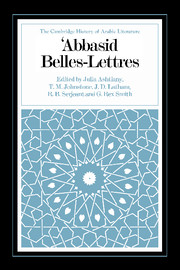Book contents
- Frontmatter
- The ʿAbbasid Caliphate: a historical introduction
- 1 Adab and the concept of belles-lettres
- 2 Shuʿūbiyyah in Arabic literature
- 3 Ibn al-Muqaffaʿ and early ʿAbbasid prose
- 4 Al-Jāḥiẓ
- 5 Al-Ṣaḥib Ibn ʿAbbād
- 6 Abū Ḥayyān al-Tawḥīdī
- 7 Al-Hamadhānī, al-Ḥarīrī and the maqāmāt genre
- 8 Fables and legends
- 9 ʿAbbasid poetry and its antecedents
- 10 Hunting poetry (ṭardiyjāt)
- 11 Political poetry
- 12 Love poetry (ghazal)
- 13 Wine poetry (khamriyyāt)
- 14 Mystical poetry
- 15 Ascetic poetry (zuhdiyyāt)
- 16 Bashshār b. Burd, Abū ʾl-ʿAtāhiyah and Abū Nuwās
- 17 Al-Mutanabbī
- 18 Abū Firās al-Ḥamdānī
- 19 Abū ʾl-ʿAlāʾ al-Maʿarrī
- 20 Literary criticism
- 21 Ibn al-Muʿtazz and Kitāb al-Badīʿ
- 22 Regional literature: Egypt
- 23 Regional literature: the Yemen
- Appendix: Table of metres
- Bibliography
- Index
1 - Adab and the concept of belles-lettres
Published online by Cambridge University Press: 28 May 2012
- Frontmatter
- The ʿAbbasid Caliphate: a historical introduction
- 1 Adab and the concept of belles-lettres
- 2 Shuʿūbiyyah in Arabic literature
- 3 Ibn al-Muqaffaʿ and early ʿAbbasid prose
- 4 Al-Jāḥiẓ
- 5 Al-Ṣaḥib Ibn ʿAbbād
- 6 Abū Ḥayyān al-Tawḥīdī
- 7 Al-Hamadhānī, al-Ḥarīrī and the maqāmāt genre
- 8 Fables and legends
- 9 ʿAbbasid poetry and its antecedents
- 10 Hunting poetry (ṭardiyjāt)
- 11 Political poetry
- 12 Love poetry (ghazal)
- 13 Wine poetry (khamriyyāt)
- 14 Mystical poetry
- 15 Ascetic poetry (zuhdiyyāt)
- 16 Bashshār b. Burd, Abū ʾl-ʿAtāhiyah and Abū Nuwās
- 17 Al-Mutanabbī
- 18 Abū Firās al-Ḥamdānī
- 19 Abū ʾl-ʿAlāʾ al-Maʿarrī
- 20 Literary criticism
- 21 Ibn al-Muʿtazz and Kitāb al-Badīʿ
- 22 Regional literature: Egypt
- 23 Regional literature: the Yemen
- Appendix: Table of metres
- Bibliography
- Index
Summary
Adab, the general term used in modern Arabic for literature or belles-lettres, is often also applied by Arab and western scholars to a body of medieval writings (such as those described in chapters 2 to 6 of this volume) which has come to be regarded as constituting a specific literary genre. At the same time, the term adab is frequently encountered among medieval Arab writers in a variety of applications, and, though some of these have literary connotations, none corresponds exactly to either of the modern meanings of the word adab. C.A. Nallino first noted these divergencies and attempted to outline the development of the term. Adab was widely used in the Middle Ages in the sense – among others – of “philology”, “literary scholarship”, “literary culture”, and perhaps it was this use of the word that led nineteenth-century translators to adopt the plural ādāb to designate European works of literature. In so doing, they lent the word an added dimension, since the new application coincided with the introduction of new notions of what constituted literature and literary studies. Nevertheless, Nallino argues convincingly that there are medieval precedents for the use of adab to designate something like the modern concept of literature (taken, in the limited sense, as comprising verse, prose and historiography); thus we find the word applied to “witticisms, aphorisms, anecdotes, elegant verse” “pieces of poetry, curious tales”; philologists, meanwhile, used adab in the more precise sense of poetry and artistic prose. More recently, Charles Pellat has questioned the appropriateness of Nallino's acceptance of adab as a term for “literature” on historical grounds.
- Type
- Chapter
- Information
- Abbasid Belles Lettres , pp. 16 - 30Publisher: Cambridge University PressPrint publication year: 1990
- 12
- Cited by



